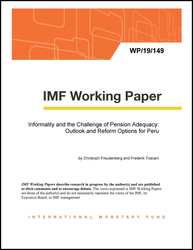No book found.

Informality and the Challenge of Pension Adequacy: Outlook and Reform Options for Peru
Past reforms have put the Peruvian pension system on a largely fiscally sustainable path, but the system faces important challenges in providing adequate pension levels for a large share of the population. Using administrative microdata at the affiliate level, we project replacement rates in the defined benefit (DB) and defined contribution (DC) pillars over the next 30 years and simulate the impact of various reform scenarios on the average level and distribution of pensions. In the DB pillar, the regressive minimum contribution period should be re-thought, while in the DC pillar a broadening of the contribution base and/or an increase in contribution rates would help increase replacement rates relative to the baseline forecast of 25-33 percent. A higher net real rate of return than assumed in the baseline would also have a significant positive impact. In the medium-term, labor market reform to tackle informality, and a broad pension reform to restructure the system and avoid competition between the DB and DC pillars should be a priority. Given low pension coverage, having a strong non-contributory pillar will remain important for the foreseeable future.
Publication date: July 2019
ISBN: 9781498318525
$18.00
Add to Cart by clicking price of the language and format you'd like to purchase
Available Languages and Formats
| English |
Prices in red indicate formats that are not yet available but are forthcoming.
Topics covered in this book
This title contains information about the following subjects.
Click on a subject if you would like to see other titles with the same subjects.
Pension System , Contribution Density , Replacement Rates , Peru , replacement rate , SPP , contribution rate , asset-based , SNP
Also of interest
Summary
Copyright © 2010 - 2025
Powered by:
AIDC



